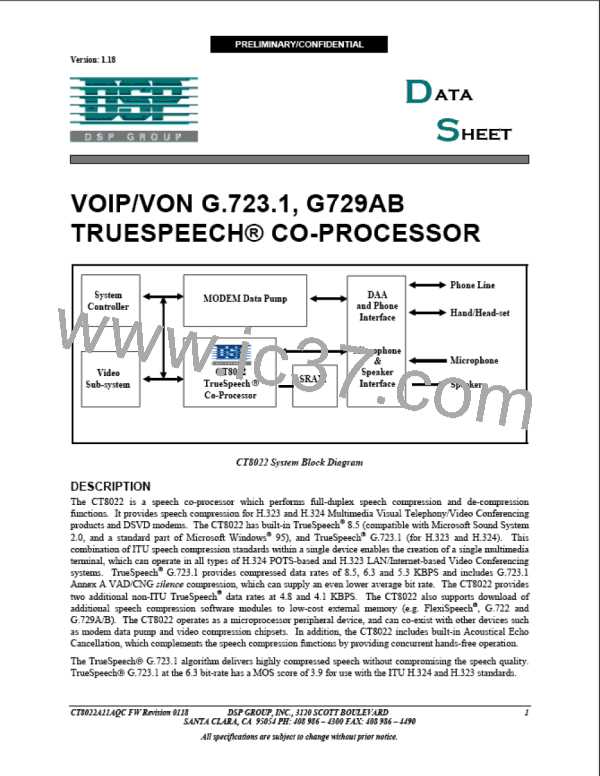TrueSpeech® Co-Processor
PRELIMINARY/CONFIDENTIAL
Version: 1.18
However, use of error correction schemes either entails a higher bit rate (in the case of forward-error correction) or
increased latency (delay) in the case of error correction by error-detection-and-re-transmission. Both techniques are
usually undesirable on real-time speech links. The Host-to-Host link should include some error detection mechanism
(e.g. checksum or CRC) so that the Host can detect corruption of speech data frames. Since the speech is highly
compressed, every bit in the speech frame is significant. If a single bit is in error, a major disturbance (noise) may be
generated in the speech signal if the damaged frame is decoded. In this situation, the Host should detect and discard
damaged speech frames and instruct the CT8022 to create a (undamaged) frame to replace it. This process of
detecting, discarding and replacing damaged frames is known as frame erasure.
The G.723.1 (and G.729 Annex A) includes a built-in frame erasure mechanism for replacing missing or corrupt
speech frames. The frame erasure system (for use with the G.723.1 6.3, 5.3, TrueSpeech 4.8 and 4.1 rates, and
G.729A) is independent of the mechanism described above. The G.723.1/G.729A frame erasure system performs an
intelligent extrapolation of data from previous speech frames in order to replace missing frames. This feature is
activated by use of specially coded speech frames.
7.5
Buffer Freezing (Pausing)
The CT8022 supports freezing or pausing of the transmit and receive buffers. Freezing of the transmit (playback)
queue enables the Host to pre-load frames into the playback channel before the start of playback. In a system where
the Host deliberately introduces delay into the channel to smooth an uneven data transmission rate, this feature
allows the Host to utilize the CT8022 internal buffer space to store the speech reservoir used for smoothing.
7.6
Variable Buffer Depth
The CT8022 includes 480 bytes each of buffer space for the playback (transmit) and record (receive) queues. In
A-law/µ-law or 8-bit mode, this is sufficient for two 240-byte µ-law frames (60ms delay) or 15 32-byte TrueSpeech
8.5 frames (450ms delay). In 16-bit mode, this space can hold only a single 480-byte frame (30ms). By default, the
CT8022 will use all of this space. However, the Host may wish to limit the amount of buffering the CT8022 uses in
order to limit the maximum amount of delay in the speech channel. The CT8022 includes functions to set a limit on
the effective buffer depth, which is lower than the physical size for just this purpose.
7.7
Silence Generation During Transmit (Playback) Data Under-run
If data under-run occurs during playback, the transmit buffer becomes empty and the CT8022 will default to
repeatedly outputting the most recent speech frame up to a (default) limit of 8 times. This behavior is appropriate to
mask a short 1 or 2-frame period in which playback data is not available. Repeating the most recent frame once or
twice causes the least perceptible break in the playback continuity. However, if the data under-run condition persists
for a longer period, the repeated playback of a single frame can be annoying to the user. The Host can program the
auto-repeat limit in the range of 1-15. Programming the auto-repeat limit to zero will cause auto-repeat to operate
continuously. When the auto-repeat limit is exceeded, the CT8022 will output silence until more playback data
becomes available.
With the G.723.1 and G.729A coders, the Host may elect to trigger the frame erasure mechanism instead of using the
auto-repeat feature.
7.8
Inserting Silence Frames during TrueSpeech Playback
The CT8022 will interpret TrueSpeech 8.5-4.1 data frames that have all words set to zero as silence frames. Each
time the CT8022 receives an all-zero TrueSpeech frame, it will output 30ms of silence. This applies to all five
TrueSpeech Rates - 8.5, 6.3, 5.3, 4.8 and 4.1. Note that this is a CT8022-specific feature. It is not a part of the
standard TrueSpeech or G.723.1 implementation. The G.729A speech coder reserves the all-zero speech frame for
use in triggering frame erasure.
48
DSP GROUP, INC., 3120 SCOTT BOULEVARD CT8022A11AQC FW Revision 0118
SANTA CLARA, CA 95054 PH: 408 986 – 4300 FAX: 408 986 – 4490
All specifications are subject to change without prior notice.

 ETC [ ETC ]
ETC [ ETC ]